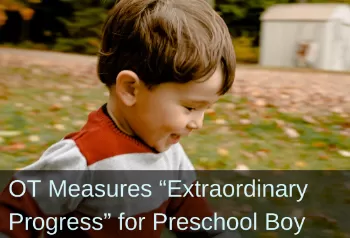Primitive Reflex Integration Case Studies
In 12 weeks, At-Risk 4-Year-Old Boy Scores at Age Level on Beery Visual-Motor Test
Rhythmic movements and primitive reflex integration offer help for visual processing issues, coordination, and more.
Assessed as at-risk and below average for visual motor tasks via the Beery Visual-Motor Test, this preschooler was struggling in school, as well as with fine and gross motor skills. Over the course of 12 weeks, his OT used tools from the Brain and Sensory Foundations First Level course resulting in "extra ordinary progress," including bringing him up to age level in design duplication on the Beery Visual-Motor Test.
Submitted by Michele Riak OTR/L

| Before | After |
|---|---|
| Poor coordination and motor planning; often fell | Able to jump from two different colored cube chairs to a colored mat on verbal cues |
| Assessed as at-risk and below average for visual motor tasks via the Berry Visual-Motor Test | Tested at age level in design duplication on the Beery Visual-Motor Test |
| Unable to track lit-up dots, most notably on his right side | He is now tracking bilaterally with increased ease |
| Impulsive | Impulsivity has reduced considerably |
Michael came in with weakness. His preschool teacher complained that Michael was the last to transition to everything despite being in the classroom for 8 months. She and mom reported that Michael fell often and had poor coordination globally and poor hand skills for pre-writing tasks.
Week 1
Began some sensory input for mom and discussed motor planning and positioning to improve his strength, upper weight bearing tolerance and motor planning skills. Began assessing his coordination which was lacking significantly as well as his bilateral integration needed for pre writing tasks.
Week 3
Changes were subtle. Michael was eager to come to classes and perform tasks. Noticed postural alignment issues as well as difficulty separating the two sides of his body and coordinating both sides. Midline crossing was affected as well. Began rhythmic movements. [From the Brain and Sensory Foundations course].
Week 5
Mom came in and said the classroom teacher was so excited about positive changes in Michael’s playground skills and transitions which are easier now. Continue to perform the rhythmic movements and now added [TLR-Tonic Labyrinthine Reflex] exercises .
Week 7
Biggest changes! Michael was able to jump from two different colored cube chairs to a colored mat. I did this with verbal cues yelling out a color and having him jump to the color. We increased the speed of the sequence and his accuracy and motor planning were terrific. Began more tasks working on cross march and puppet march. Did puppet march on a mat which was placed on top of a low bolster. This helped Michael achieve the knee bend while having his mom help him to lift the same side arm up. He had great difficulty doing this on his left side. Michael was able to crawl with me and do high five and “bark “ to each other with improved head turn. Head turn to the right is still a challenge and he does twist his whole body.
Week 10
Continued working with Michael during sessions however his behavior worsened and his tolerance of treatment became less and less. Mom admitted that they stopped doing home carry over. She also said that Michael recently had a kindergarten readiness evaluation at his preschool and he was deemed at risk and below average for visual motor tasks via the Beery and handwriting difficulties.
Worked with mom for two weeks reviewing rhythmic movements and the Activities to integrate ATNR [Asymmetrical Tonic Neck Reflex], STNR [Symmetrical Tonic Neck Reflex]. Instructed mom on Babinski, foot reflexes and hand reflexes. [All from the Brain and Sensory Foundations course].
Week 12
Michael has made extraordinary progress. He had great difficulty four weeks ago with dynavision. Unable to track lit up dots most notably on his right side. In the past few weeks mom has been vigilant with carry over performing rhythmic movements daily. Work with hands and feet has made a huge difference. Paper snowballs, picking items up with toes, isometrics with digits, walking on heels, toes, inside and outside of feet. Gave Michael the Beery this week and he was at age level in design duplication. He is now tracking bilaterally with increased ease!!!
Week 14 - 16
Started working with Michael on independent cross walk and puppet march. He is very tolerant of Moro integration and isometric activities [From the Brain and Sensory Foundations course]. Mom was instructed and will work on these with Michael. Previously he was unable to perform puppet march or cross walk independently. After one and a half weeks he is able to perform these independently (watching therapist do it with him). He enjoys moro [reflex] isometrics and mom and I have noticed his impulsivity has reduced considerably!
[Edited for length and clarity, emphasis added]
*Disclaimer: The activities in the Brain and Sensory Foundations curriculum make use of the natural processes of neuroplasticity and development that are innately wired in the design of human beings to promote maturity and function. These activities appear to calm, organize, and mature the neuro-sensory-motor systems just as we see in the healthy development of human infants. Individual results may vary, and we do not claim to offer a diagnosis or cure for any specific condition or disorder. The Brain and Sensory Foundations activities appear to improve overall functioning resulting in measurable improvements for a range of conditions as demonstrated in over 1800 case studies from participants.

